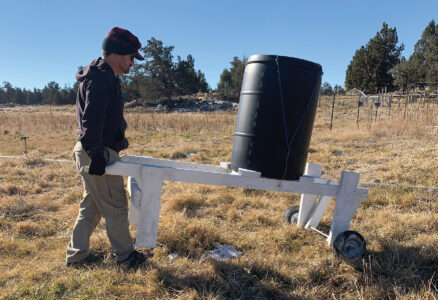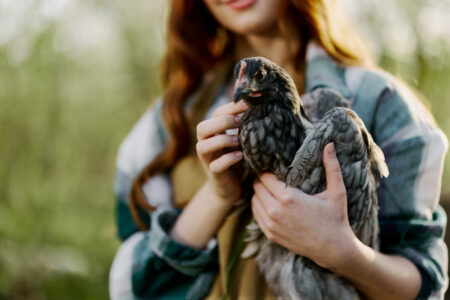This easy-build DIY project will provide your flock with a large homemade chicken feeder that can be rolled around your property. You only need a barrel, some wood, and a few pieces of hardware — all of which can be upcycled — to make this no-waste chicken feeder.
The first time I saw a chicken watering nipple, it felt like a Christmas miracle. I remember thinking, “Why isn’t there something similar in the form of a homemade chicken feeder?”
Flock feeders haven’t changed much in 100 years. Maybe it’s because they’re tried-and-true and inexpensive to manufacture. But plastic feeders tend to break. Birds like to perch on a metal feeder’s top rim and do their business over the edge, into the feed. Neither of these feeder types will keep feed dry outdoors, which is where chickens like to eat. Some good rodent-free options are on the market, but they don’t curb the birds from launching feed everywhere, like a truck spreading salt on an icy road. For some reason, the feed they’ve scattered is never good enough to go back and eat.

I was thinking about designing my own large chicken feeder DIY project when I stumbled upon a popular plan on the web. Similar to the way watering nipples work, this design depends on chickens doing what they like to do best — pecking and scratching. Rather than ignoring the birds’ instincts, it relies on them to do what’s natural. The feed is positioned in a barrel overhead and will fall to the ground, where poultry like to eat. Birds peck overhead at the feeder until — bless their short attention spans — some food falls down, and they forget about pecking until they’ve scratched at what’s on the ground.

This design has many great features. First, because the feeder hole is on the bottom of the barrel holding the food, it’s protected from the weather. Second, it wastes less feed, because the latter is released only upon interest, and then the interest shifts quickly to the ground. Third, because the opening is upside-down and high off the ground, it’s particularly difficult for rodents to access.
Build a Better No-Waste Chicken Feeder
At the center of this homemade chicken feeder project is a plastic 55-gallon drum for holding the feed. Why so big? Because I want to be a lazy chicken wrangler, meaning I prefer to check feed levels only infrequently — and I certainly don’t want to refill often. Having a huge, full barrel also provides ballast for the inevitable wind gusts, which would play ninepins with a smaller bucket. To build this design, you can also use a trash can, a lidded metal drum (often harder to find than a plastic drum), or even a 5-gallon bucket. Be sure to use a clean, dry barrel or bucket that’s never been used to store toxic substances.

By a miracle of coincidence or of ingenious design, the top of most plastic 55-gallon drums narrows just before flaring into a big lip. If you cut off the top where it’s skinniest, you can flip the lid upside-down so the flared lip will form an overlapping seal on the now-open barrel top, which is where you’ll eventually be pouring in the feed. Cut off the lid with a handsaw or reciprocating saw, and then tighten the existing bung and caulk it closed, because rainwater will accumulate on the lid, and you don’t want it to leak into the barrel and spoil the feed.
To create the feeder hole, drill a small hole in the center of the bottom of the barrel. If you have a big flock, drill several holes. The great thing about this no-waste chicken feeder is that food will issue from these holes only when the chickens peck — but you will need to install a device to prevent feed from pouring freely through the hole (or holes) except when the birds want it. As with a chicken-watering nipple, the device should wobble inside the hole. The easiest thing for you to do will be to insert an eye bolt, threads-down, into this hole. In operation, the birds will peck at the threaded bottom, causing the loop to stir the feed and drop it to the ground below.

Although eye bolts are easy to get and install, their threads provide a grip for ambitious little critters to jump onto. Instead, you can bend 7-gauge wire into a similar loop-and-shaft shape to make your wobbling feeder bolts. Or, if you have a spare tent stake, bend the head into a loop.
The size of the feeder hole will depend on what you’re feeding your chickens— drill larger holes for coarser food — and how much food you want to fall out at a time. If you’re using a plastic barrel and you’ve got a heavy predator population, you may want to glue or caulk a large fender washer over each hole to prevent it from being enlarged by gnawing. I like to keep a few fender washers around for when I’m varying the feed, because I’ll end up with a lot of food on the ground if I’m feeding cracked corn through a hole that was drilled for pellets. To govern the flow of fine feed, I simply select a washer with a smaller hole and put it over the top of the existing feeder hole. The eye bolt keeps it in place.

If some of your birds are reluctant to start pecking, pick them up and gently nuzzle the feeder bolt with their head, and they’ll learn quickly.
I fashioned a large funnel for the bottom of the barrel interior so the food would slide to the feeder hole when it got low. If I was building this homemade chicken feeder again, I’d instead fill the bottom with oyster shells or dirt as ballast and as an indicator that it’s time to refill. Depending on the type of feed (and especially with crumbles), you may need to bang on the side of the barrel occasionally to get it to settle to the bottom.
A Frame to Keep Your Homemade Chicken Feeder Moving
To keep the feed barrel off the ground, I built a sturdy wooden frame on wheels, which allow it to be moved with relative ease. When you assemble the wheeled cart for your own feed barrel, consider who’ll be moving and filling it, where that person will be wheeling it, and the wind. Old lawn mower wheels will work, but larger pneumatic wheels will be less likely to sink into wet ground and easier to roll.

Take the wheels and their mounting position into account when deciding on the height of the cart of this large chicken feeder DIY project. I like to have the bottom of the barrel about 20 inches off the ground. If a smaller person would be moving the cart, I’d place the filled feed barrel closer to the wheels to give the operator more leverage. Too far over the wheels, though, and the barrel will be prone to upending if other animals lean on it, the wind is strong, or the operator hits a bump while rolling. Some flock owners may find it necessary to keep a small stepladder nearby for filling purposes. After the barrel is filled, I secure the lid in place with bungee cords.
In my experience, 6 feet is the right length for the cart, and 2 feet in width should accommodate most barrels. Start by building a 2×4 frame with a pair of crossbeams arranged to make a square where your barrel will stand, and then add retaining blocks in the corners to keep the barrel centered. Add legs about 1 foot away from the handles so you won’t trip on them while you’re moving the cart. Add a broad cross-brace high up on the legs (again, positioned to keep you from kicking it). On the wheeled end, you may want two legs to form a triangle (as shown in the bottom photo above), or one wide leg on each side with another cross-brace for plenty of support.

For an axle, a proliferation of 5/8-inch rods are available online for less than $20. Make sure this diameter matches your chosen wheel options. I opted for a 36-inch-long rod to give the cart a wider stance, and this required spacers made of PVC pipe to keep the wheels centered.
With everything assembled and stocked, it’s time for a trial run of your homemade chicken feeder. Park the mobile cart directly over a stubborn weed patch and watch your chickens raze it like the Romans sacking Carthage!
Josh Lau is an engineer, inventor, and Eagle Scout. He raises chickens and steers on a small ranch in central Oregon with his patient wife and awesome kids.
Originally published as “Mobile Poultry Feeder” in the March/April 2023 issue of Grit and regularly vetted for accuracy.







